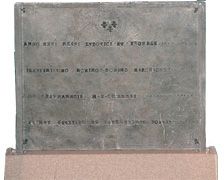The Gift of South Dakota
Subscriptions to South Dakota Magazine make great gifts!
Subscribe today — 1 year (6 issues) is just $29!
Louie, Louie, Rene and Me
Dec 16, 2014
No matter how organized I try to be, my important documents are rarely where I think I put them. If I need my car registration, for example, it won’t be found in the vinyl pouch labeled “Registration.” It will be smashed into a corner of the glove compartment with my wintertime emergency rations, a bag of Jube Jells, melted all over them.
I’ve always found it interesting that I can readily produce a registration and title, which prove I own my car, but I don’t have anything like that for my house. Each year the Yankton County Registrar sends me a real estate tax bill, so apparently I do own the property. I just wish I had a deed — an actual piece of parchment with a big gold seal and a little red ribbon thereunto affixed — that I could hang on the wall.
There’s another thing I was thinking about while I was supposed to be listening to … well, never mind. When we bought our house the seller didst convey and transmit to us an abstract, a curled up sheaf of papers that detailed who owned our property all the way back to Adam and Eve.
Okay, I’m joking. The record only goes back to 1871, when the land my house sits on was part of a homestead claim authorized by President Ulysses S. Grant himself. As a dabbler in things historical, I found that document quite interesting. It provided a chain of ownership, nice and neat and legal, all the way back to Ulysses.
So how did Ulysses come to own my property? Let’s step into the Way Back Machine and find out. Our first stop is 1803, when my property and most of South Dakota belonged to Napoleon. He needed cash to buy cannons and croissants for his army more than he needed land in far-off America, so he sold it all to the United States for $15 million. This was the famous Louisiana Purchase. So far so good. Nice and neat and legal.
How did Napoleon come to own this territory? He got it from the king of Spain, who had in turn obtained it from the king of France. This back and forth was all quite complicated, with secret treaties and whatnot, but it gets us back to 1762 and everything is cool, title wise.
How did the king of France come to own my property in the first place? This is where things get hinky. About 20 years before that, the Verendrye brothers, Louis-Joseph and Francois, were wandering about these parts in search of magic mountains and silver cities. They had heard tales of such from the Mandan, who lived along the upper Missouri River in what is now North Dakota.
When we pause the WBM at that point we see a couple of Mandan waving goodbye to the Verendryes, and the instant the Frenchmen are out of sight the Indians fall to the ground, convulsed by laughter.
“Magic mountains!” howls one, tears streaming down his face. “How did you come up with that?”
“It just came to me!” shrieks the other. “What about you? Silver cities? I can’t believe they bought that!”
“I know! I wonder if all white men are that gullible?”
The New World’s native people were always shining European explorers on like that. Fountains of youth. Cities of gold. There didn’t seem to be anything they wouldn’t swallow, but I digress. Louis and Francois never found any silver cities, and the Black Hills turned out not to be magical. On March 30, 1743, Louis did, however, plant a lead plaque near the mouth of the Bad River. Inscribed on it were these words: “Those #&%@ lying Mandan! I haven’t seen any silver….”
Just kidding. Louis scratched his name and the date on the back, then placed the plate under a rock cairn. By doing this he claimed my property and most of South Dakota for King Louis XV of France. There were thousands of Arikara living along that stretch of the Missouri in 1743. No one recorded what they thought of this curious legal procedure.
There’s more. As it turns out, France already owned my property, thanks to René-Robert Cavelier, Sieur de La Salle. He was a French explorer who floated down the Ohio River to the Mississippi, then to the Gulf of Mexico. When he got there, on April 9, 1682, Rene buried another lead plaque in the sand and claimed all the land drained by the great river for King Louis XIV of France. Talk about low closing costs!
Let’s recap. My title to my house — and your title to yours, perhaps — is nice and neat and legal because it came to me through Ulysses and Napoleon and a couple King Louies, who owned the land because René buried a plaque in the sand 1,300 miles from here.
I wonder if this sweet procedure is still legal? I’ve had my eye on this great house with a three-car garage and a pool, and I’ve got some lead ….
Editor’s Note: This column is revised from the September/October 2011 issue of South Dakota Magazine. To order a copy or to subscribe, call (800) 456-5117.










Comments
If and when RH passes please do not get in a hurry to bury him.
I'm sure there will one or two hilarious columns left in him!
The whole magazine is great, but I always look to see what Roger
has come up with for the current issue.
Thanks again. Good luck with your property acquisition!